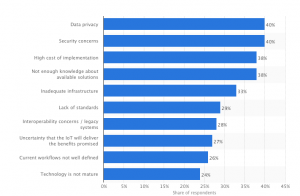
The Internet of Things (IoT) is growing at a rapid pace; Intel predicts 200 billion devices will be connected by 2020.
Furthermore, the opportunities that comes with IoT are vast. And companies across the globe are investing in this new technology to reap financial benefits and improve efficiencies. By using “smart” technology, B2B businesses will improve legacy systems, increase productivity, and automate processes with data.
In our Internet of Things market analysis, we'll take a look at the effect IoT is having on different industries, the financial impacts, and buyer concerns.
 Buyer's top concerns about IoT adoption
Buyer's top concerns about IoT adoption
 Factors slowing B2B IoT adoption.
Factors slowing B2B IoT adoption.
For buyers, companies in the IoT stack must focus on helping them understand the technology better: its risks, interoperability concerns, and especially its potential value-add.
But while the consumer-facing benefits of IoT are simple — a more efficient home energy system, an "assistant" that facilitates personal tasks and preferences — the B2B benefits are deeper investments with longer-term returns. So it’s important that Internet of Things marketing messages specify the IoT values and benefits for B2B companies. And value is especially important to relay to both industry executives and technical buyers tasked with signing off on IoT solutions.
Now, let’s take a look at which industries stand to benefit the most from IoT.

The impact IoT can have on industries such as manufacturing and healthcare is incredible. And IoT can make manual processes automatic and improve information sharing between machines as well as between humans. So the big question many businesses and speculators ask is: How much is this all worth?
The pressure sensor market alone is expected to increase from $1.5 billion in 2014 to over $1.9 billion in 2019.
So there’s no question that IoT is valuable, as companies and public-sphere organizations invest in devices, software, and services. But how will B2B businesses spend resources on IoT?
Companies that invest in IoT now are seeing a great return. And it looks like that spending will not slow down anytime soon. So as spending is increasing, what will happen to the future of IoT?
Only 0.06% of "things" that could be connected to the IoT have been integrated into the stack — AKA, only 10 billion things out of the 1.5 trillion that exist globally are currently connected (Link-Labs).
In conclusion, IoT will change the way we do things in a personal and business setting. And the potential savings and earnings are high. Therefore, many organizations are trying to tap into the power of IoT. As more connectivity comes, more innovation is sure to follow.
by Jonathan Franchell, CEO of Ironpaper - For more tips and hacks: Need to remove a new line after h1 tags? Both web designers and SEO practitioners need to employ headline tags: H1, H2, H3 in several ways to improve web page structure and tag...

The Crowded Arena of the IT Marketplace Updated December 2024 The Information Technology (IT) landscape is experiencing rapid growth and intensifying competition. IT spending is projected to reach nearly 5.1 trillion U.S. dollars in 2024, a...

Updated December, 2024 The field of digital marketing is evolving rapidly in response to new technology and changing buyer expectations. To help career-minded marketers, we’ve rounded up the top 10 skills needed to succeed in the field. These are...

The marketing industry is transforming significantly due to generative AI and increasing market complexity. Gartner's prediction of a 25% decline in traditional search traffic suggests that the era of search engines is dying. AI tools, particularly...
